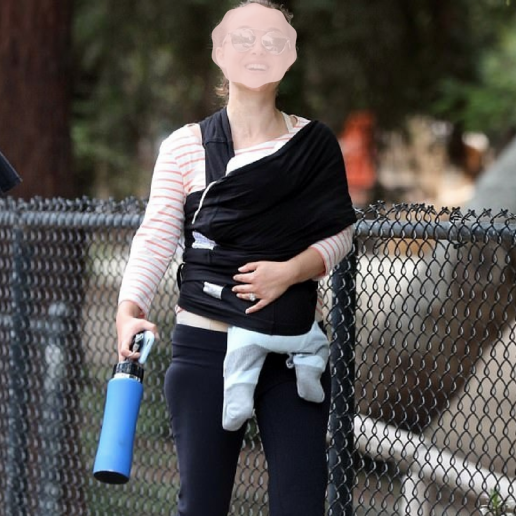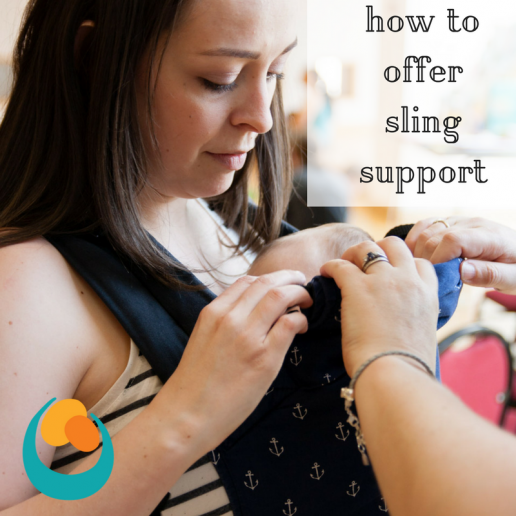How do you approach and talk to someone who is using a baby carrier when you don't know them and have just seen them out and about?
Most of the time when we “sling spot” someone, it is an exciting experience, seeing someone else enjoying babywearing as much as we do. We nod and smile and enjoy a shared moment of connection, and some of us may even go and strike up happy conversation and make a new friend. However, sometimes we may come across a baby in a carrier that makes us feel anxious and we feel we should be offering sling support. What should you do next?
This situation can be really difficult, especially if you are worried about the safety of the baby in the sling. Few of us want to be annoying or interfering, or to come across as irritating busybodies, or to appear judgemental. This natural reticence that most of us have is good; it means we are less likely to plough in, say something that comes out badly, upset a vulnerable parent and end up putting them off their sling entirely, giving the sling community a bad reputation and potentially robbing a family of a very valuable tool that may be making a significant difference to their lives.
On the other hand, safety DOES matter… babies must be able to breathe unobstructed at all times, and should always be snug and tight and supported hands-free in a sling, especially those under four months of age. Babies in these first early months of life are at their most vulnerable and we all want to do our best to protect them.

What are the main safety issues we should be aware of? Which ones are really important and which ones matter much less? How can we judge this from across the road?
- One issue that is always always important is the child’s airway. Is the child able to breathe easily with no obstructions to an open airway? Airway compromise could be due to problems such as slumping forwards with chin sunk onto chest, fabric over baby’s face, being carried very low and loose, or baby not visible inside the sling at all, folded in half inside a pouch. The image above shows this in action.
- If baby is clearly not actually being supported by the sling at all and is at risk of falling out (such as in the photo here), this is also a problem. A good sling should always allow a parent to be hands-free. However, it is important to be aware that a carer may be very aware of the child and how the sling is feeling, and be instinctively keeping a protective hand on the child, reducing the risk. Have they grabbed the nearest option to be able to get out of the house and are still ensuring baby is safe?
- Issues such as using a narrow based/harness type carrier, or facing forwards (in the over 3-4months age range) are rarely safety issues. They may possibly be less comfortable, but they are not harmful per se, unless there is an airway compromise.
- The type of carrier used (buckle carrier or wrap, ring sling or meh dai) is not important, as long as the parent and child are both safe and comfy, and airway is clear. You may have a preference for one type of carrier, but that is your preference, just as the type of shoe you are wearing works for your foot shape and budget.
If there is no safety issue, you do not need to get involved at all, just enjoy the fact that a baby is being carried, and move on. If you want to meet people and make friends and you are naturally that kind of person, feel free! You’ve identified what really matters, you know this isn’t about safety, you’re aware of the possible background and just want a human interaction that leaves you both feeling good. Avoid any kind of judgemental comment or “sling shaming.”
So, what do you do if you have a genuine concern?
It is important to remember three things.
1) Be kind.
Parenting is hard work; many of us have very little support around us and have to work it out alone. This parent has already made a positive choice to carry their baby, this is wonderful news. It may be enormously helpful in surviving from day to day. They may already have slight misgivings if it is uncomfortable, they may already be getting pressure from friends and family to stop due to all the misunderstandings and myths about sling use (such as making children “clingy”). The wrong tone from you may be the last straw. So, be kind in your approach, take the time to think about how you can be compassionate and encouraging.
2) Connect.
There are so many benefits to carrying children, to baby, carer and society, that your ultimate goal is to encourage the parent to continue using their sling. Go into any conversation with a positive, empowering attitude, aiming to make a connection that lifts the other person up. Share your own joys in carrying your own baby; this builds a bridge of shared experience. If they feel criticised or attacked, they will react badly. If a person feels valued and respected, they will be more likely to accept offers of support. Try to frame them in a non-directive way, and be guided by how the parent responds. Keep your body language open and your voice gentle and friendly. Smile!
Oh, you have a carrier! I had one too! I really loved my baby carrier. It helped me to cope and my baby got so much out of it too. The snuggles were lovely. How are you finding yours?
I remember being really worried about how my baby was breathing when I was just starting out. The people at the local sling library were able to help me. Is this a worry you have too? I can help you if you’d like?
Oh, I had one of these carriers as well! It was so helpful. Are you enjoying yours? …. Yes mine wasn’t the most comfy either, but I didn’t want to stop carrying my baby and having my hands free, I went to the local sling library and they helped me find something that was much kinder to my back. I can give you their details if you like?
3) Know your own boundaries.
Some of us find it easier to talk to strangers in the street. Others find this very scary… remember, you only need to do what you feel able to do, and most babies are just fine in their carriers. If you feel you have to get involved, but feel too anxious to talk, it may help to have some sling library cards or leaflets in your bag that you can hand out with a small smile and a quick hello. Remember, you are not responsible for other people, so don’t weigh yourself down with guilt that isn’t yours. Talk to your local sling professional if you’d like to feel more confident about offering sling support. They can help you practice what to say or guide you towards safety training if you wish.
What about online?
The sling community can be a great place for people to join, especially if it is focused on encouragement and mutual enjoyment of carrying children. These principles of kindness and connection will apply just as much online too; perhaps more, as public social media posts are often read by many, many other people who all form opinions based on what they read. A one-to-one face to face interaction has all the advantages of non-aggressive body language and gentle tone of voice to be disarming when passing on difficult information. Online, this is very different, and a vulnerable parent feeling bombarded with negativity may find this very hard to deal with, and impressions about “the babywearing community” being judgemental and quick to find fault are not helpful to anyone.
In summary, remember we are all human beings with feelings, all trying to do the best for our children. Keep that in mind and you won’t go far wrong!


